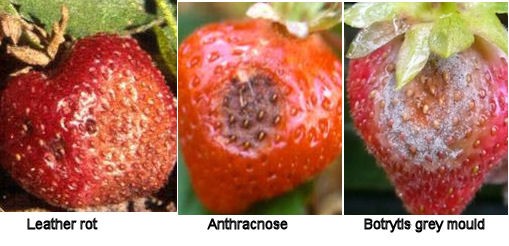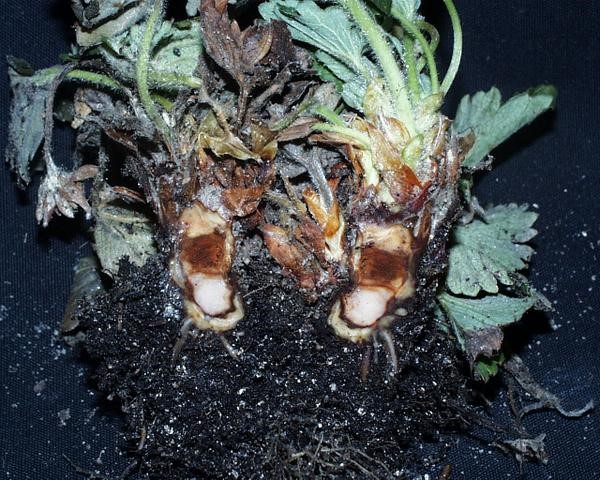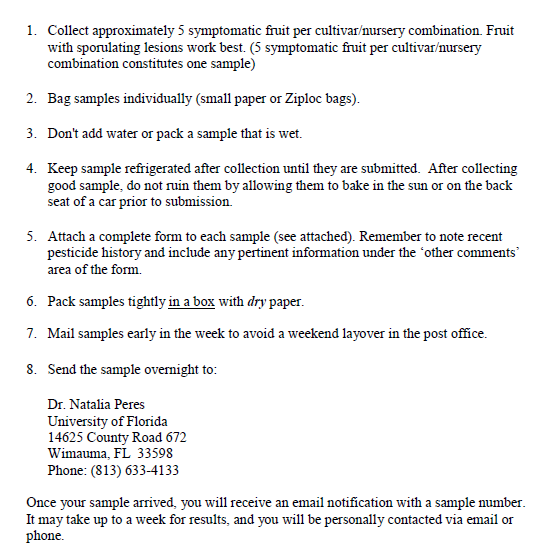
Wet Spring, Perfect Storm for Disease Development in Strawberry
All of the rain this spring has created the "perfect storm" for diseases to develop in strawberries. Here is what to look for and how to treat them!
The strawberry crop has made it through a few scares already this season. We had some temperature swings that caused a bit of freeze damage but for the most part the berries pulled through. Now we are about to battle rainier weather and with that will come disease (Fig. 1). In order to protect your berries you will want to put out a fungicide spray before the rains hit but make sure to allow time for rain fastness, refer to label. If you can’t beat the rain make sure to get an application out soon after. There have been reports of leather rot, which can be prevented with the fungicides Aliette or Ridomil Gold. These fungicides will also be effective for root rot. I have seen a bit of root rot already this season, especially in water logged soils. If your soil is poorly drained, you will want to keep up a good management program with Ridomil and Alliete in the line-up along with Fosphite. We have also had reports of botrytis gray mold which can be managed with many fungicides. Here is a link to a strawberry production guide that has a great list of fungicides and also details when to use the products for root rot, botrytis and other strawberry diseases http://www.smallfruits.org/ipm-guides.html. Remember to always read the pesticide label for rates and application instructions.
Correct Disease ID is Important!
If you are currently having disease issues in your strawberries; it is important to diagnose the issue. We have experienced major rains which will cause very high disease pressure during harvest. If you are seeing lesions on the berries like the below pics, take a berry sample (include stems on the picked berry) to your local county office and tell them you want testing for leather rot and anthracnose. We are seeing both anthracnose and leather rot at high rates this year due to the wet weather. Leather rot and anthracnose are managed with different fungicides. Sprays you put out for anthracnose and botrytis management will NOT control leather rot. For leather rot control you must use Ridomil or Aliette (Refer to labels for suggested rates).
Phytophthora is another disease you may be experiencing, which can cause the plants to produce little, grow slowly, and ultimately collapse. To get testing for this one, you must provide the whole plant including the root system to your local county agent. Again, Aliette and Ridomil are treatments.
If you have a confirmed case of anthracnose, please also send a sample to University of Florida. They are testing for specific strains of anthracnose at University of Florida and can give you detailed information on which pesticides will work the best for your specific strain of anthracnose. This can only be done through U of F so you will have to mail your samples there by following the below directions. Since we now have some pesticide resistance building this will continue to be important.
Fig. 1. Common strawberry diseases that can be managed with fungicides. Photo courtesy of Ontario CropIPM.

Fig. 2. Phytophthora crown rot is characterized by a reddish brown color, when the crown is split in half. Photo Courtesy FJ Louws, NC State University.

Sampling Directions for collection and submission of Anthracnose samples to the University of Florida Resistance Screening Laboratory:
